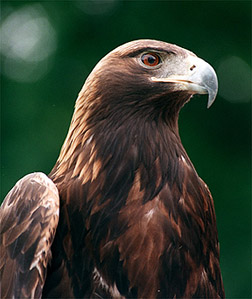|
| Query: birds of america | Result: 56th of 1888 | |
Golden Eagle (Aquila chrysaetos) - Wiki
| Subject: | Golden Eagle (Aquila chrysaetos) - Wiki
| |

| Resolution: 252x299
File Size: 27418 Bytes
Upload Date: 2007:09:04 18:28:02
|
Golden Eagle
From Wikipedia, the free encyclopedia
The Golden Eagle (Aquila chrysaetos) is one of the best known birds of prey in the Northern Hemisphere. Like all eagles, it belongs to the family Accipitridae. Once distributed across North America, Europe and Asia, it has disappeared from many of the more heavily populated areas.
The Golden Eagle is one of twelve species of large predominantly dark-coloured eagles in the genus Aquila found worldwide; a large brown bird of prey, it has a wingspan averaging over 2 m (7 ft) and up to 1m (3 ft) in body length.
Taxonomy
The Golden Eagle is one of twelve species of large eagles in the genus Aquila found worldwide. Latest research indicates it forms a worldwide superspecies with Verreaux's Eagle, Gurney's Eagle and the Wedge-tailed Eagle.
Subspecies
There are six subspecies of Golden Eagle that differ slightly in size and plumage. They can be found in different parts of the world:
A. c. chrysaetos: Eurasia except Iberian peninsula, east to western Siberia.
A. c. canadensis: North America.
A. c. daphanea: From southern Kazakhstan east to Manchuria and south-west China including northern India and Pakistan.
A. c. homeryi: Iberian peninsula and North Africa, east to Turkey and Iran.
A. c. japonica: Japan and Korea.
A. c. kamtschatica: Eastern Siberia, from the Altay to the Kamchatka Peninsula.
Description
Adult Golden Eagles range widely in size across their range. The largest races comprise the largest eagles of the genus Aquila. Length may vary from 66 to 100 cm (26-40 in), wingspan can range from 150 to 240 cm (59-95 in), and weight is from 2.5 to 7 kg (5.5-15.4 lb). As in all birds of prey, the females are generally slightly larger than the males.
The plumage colours range from black-brown to dark brown, with a striking golden-buff crown and nape, which give the bird its name. The juveniles resemble the adults, but have a duller more mottled appearance. Also they have a white-banded tail and a white patch at the carpal joint, that gradually disappear with every moult until full adult plumage is reached in the fifth year.
Distribution
At one time, the Golden Eagle lived in temperate Europe, North Asia, North America, North Africa and Japan. In most areas this bird is now a mountain-dweller, but in former centuries it also bred in the plains and the forests. In recent years it has started to breed in lowland areas again (Sweden, Denmark).
There was a great decline in Central Europe, and the Golden Eagle is now restricted to the Appennine regions of Italy (Abruzzo and Pollino), and the Alps. In Britain, there are about 420 pairs left in the Scottish highlands, and between 1969 and 2004 they bred in the English Lake District. In North America the situation is not as dramatic, but there has still been a noticeable decline. Golden Eagles can often be seen soaring above mountains in Scotland.
In Ireland, where it had been extinct due to hunting since 1912, efforts are being made to re-introduce the species. Forty-six birds were released into the wild in Glenveagh National Park, County Donegal, from 2001 to 2006, with at least three known female fatalities since then. It is intended to release a total of sixty birds, to ensure a viable population.
In April 2007, a pair of Golden Eagles produced the first chick to be hatched in the Republic of Ireland in nearly a century. The previous attempt to help the birds breed, at the Glenveagh National Park, failed.
Behaviour
Reproduction
A pair of Golden Eagles remains together for life. They build several eyries within their territory and use them alternately for several years. The nest consists of heavy tree branches, upholstered with grass.
Old eyries may be 2 metres (6.6 ft) in diameter and 1 metre (3.3 ft) in height, as the eagles enlarge their nests every year. If the eyrie is situated on a tree, supporting tree branches may break because of the weight of the nest.
The female lays two eggs between January and May (depending on the area). After 45 days the young hatch. They are entirely white and are fed for fifty days before they are able to make their first flight attempts and eat on their own. In most cases only the older chick, which takes most of the food, survives, while the younger one dies without leaving the eyrie.
Hunting
Golden Eagles often have a division of labour while hunting: one partner drives the prey to its waiting partner. They have very good eyesight and can spot prey from a long distance. The talons are used for killing and carrying the prey, the beak is used only for eating.Their prey includes marmots, hares and mice, and sometimes birds, martens, foxes, young deer, and livestock including lambs and young goats. During winter months when prey is scarce, Golden Eagles scavenge on carrion to supplement their diet.
Falconry
Golden Eagles can be trained for falconry. In Kyrgyzstan Golden Eagles are still used to hunt.
Heraldry
The Golden Eagle is featured in the national coat of arms of Germany, Egypt, Mexico and many other countries
http://en.wikipedia.org/wiki/Golden_Eagle
| The text in this page is based on the copyrighted Wikipedia article shown in above URL. It is used under the GNU Free Documentation License. You may redistribute it, verbatim or modified, providing that you comply with the terms of the GFDL. |
|
Comments |
|---|
| | Guest |
|
Scientific Name: Aquila chrysaetos (Linnaeus, 1758)
Common Names: Golden Eagle
French: Aigle royal German: Steinadler Spanish: Águila real
Taxonomy: Falco Chrysaëtos Linnaeus, 1758, Sweden. |
^o^
Animal Pictures Archive for smart phones
^o^
|
|
|